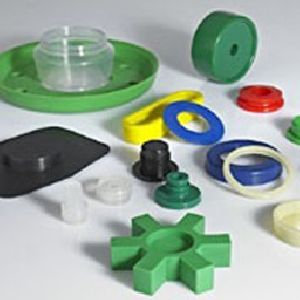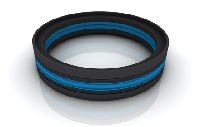
Wipers
Wipers in pneumatic and hydraulic cylinders protect the interior of the cylinder from the penetration of external contaminants when the rod is retracted.Primary and secondary seals as well as the guides of modern sealing systems require reliable protection the use of wipers. Dirt, dust, moisture and other environmental influences must not contaminate the operating medium and must above all be kept away from the pressure-loaded sealing edges and other contact zones. Depending on the application, simple wipers with or without metal reinforcement as well as double wipers with or without pressure relief come into use.
...more
Rod Seal
Rod seals are primarily used in pneumatic and hydraulic cylinders and have the task of sealing the incoming and outgoing cylinder rod. The goal is to prevent the escape of the pressurized operating medium from the cylinder. At the same time, it must be protected against external contaminants. We Offer the right rod seal for every kind of cylinder and application.Rod seals from Freudenberg Sealing Technologies are used in state-of-the-art sealing systems for cylinders of all kinds. They are specially adapted to the respective conditions of use and tasks while meeting customers’ high expectations for maximum reliability, service life and functionality. State-of-the-art hydraulic rod sealing systems generally consist of several individual seals. The so-called primary seal faces the cylinder’s working space and reliably seals against the high operating pressure within the cylinder.The secondary rod seal fitted behind it takes over the main sealing function. It is above all designed to reduce the residual oil film on the rod to a minimum during its extension. Seals constructed of polyurethane are preferably used for this task. With their defined sealing lip, they ensure the finely tuned wiping of the medium, guaranteeing the leak tightness of the cylinder toward the exterior.wipers are used as a third element in the rod sealing system, in addition to the guide elements that prevent the contact of the incoming and outgoing rod with the housing. Their task is to protect the systems’s primary and secondary seals from external contamination and influences. In addition, static seals are needed for the cover/cylinder housing intersection.
...more
Radial Shaft Oil Seal
A component of machine that seals lubricants, an oil seal is constructed of rubber, garter spring, and an internal case. While preventing the leakage of lubricants, water, or chemicals, an oil seal also prevents the entry of dust and dirt into a machine.
...more
Piston Seals
Piston seals in hydraulic cylinders have the task of sealing the piston against the cylinder tube. The goal is to avoid the transfer of the pressurized operating medium to the pressureless side, allowing the efficient and reliable movement of the piston with the lowest possible friction and without drift.State-of-the-art hydraulic piston seals can be precisely adjusted to a particular application with the selection of suitablematerials. Polyurethane and PTFE materials mainly come into use. In combination with the Freudenberg Sealing Technology geometries – which have been proven a million times over – they always provide the optimal solution.
...more
O-rings
An O-ring, also known as a packing, or a toric joint, is a mechanical gasket in the shape of a torus; it is a loop of elastomer with a round cross-section, designed to be seated in a groove and compressed during assembly between two or more parts, creating a seal at the interface. The O-ring may be used in static applications or in dynamic applications where there is relative motion between the parts and the O-ring. Dynamic examples include rotating pump shafts and hydraulic cylinder pistons.O-rings are one of the most common seals used in machine designPrimarily used for static sealing of inactive machinery components against liquids and gases. Special solutions and special forms from Freudenberg Sealing Technologies are also suitable as dynamic sealing elements, e.g. as piston or rod seals in the hydraulic system. Material Used:- 1) (NBR, HNBR, HSN): a common material for o-rings because of its good mechaNitrile rubbernical properties, its resistance to lubricants and greases, and its relatively low cost. The physical and chemical resistance properties of NBR materials are determined by the acrylonitrile (ACN) content of the base polymer: low content ensures good flexibility at low temperatures, but offers limited resistance to oils and fuels. As the ACN content increases, the low temperature flexibility reduces and the resistance to oils and fuels improves. Physical and chemical resistance properties of NBR materials are also affected by the cure system of the polymer. Peroxide-cured materials have improved physical properties, chemical resistance and thermal properties, as compared to sulfur-donor-cured materials. Standard grades of NBR are typically resistant to mineral oil-based lubricants and greases, many grades of hydraulic fluids, aliphatic hydrocarbons, silicone oils and greases and water to about 80 °C. NBR is generally not resistant to aromatic and chlorinated hydrocarbons, fuels with a high aromatic content, polar solvents, glycol-based brake fluids and non-flammable hydraulic fluids (HFD). NBR also has low resistance to ozone, weathering and aging. HNBR has considerable improvement of the resistance to heat, ozone and aging, and gives it good mechanical properties. 2) Silicone rubber (SiR): noted for their ability to be used over a wide temperature range and for excellent resistance to ozone, weathering and aging. Compared with most other sealing elastomers, the physical properties of silicones are poor. Generally, silicone materials are physiologically harmless so they are commonly used by the food and drug industries. Standard silicones are resistant to water (to 100 °C), aliphatic engine and transmission oils and animal and plant oils and fats. Silicones are generally not resistant to fuels, aromatic mineral oils, steam (short term to 120 °C is possible), silicone oils and greases, acids or alkalis. Fluorosilicone elastomers are far more resistant to oils and fuels. The temperature range of applications is somewhat more restricted. 3) Fluoroelastomer (FKM): noted for their very high resistance to heat and a wide variety of chemicals. Other key benefits include excellent resistance to aging and ozone, very low gas permeability and the fact that the materials are self-extinguishing. Standard FKM materials have excellent resistance to mineral oils and greases, aliphatic, aromatic and chlorinated hydrocarbons, fuels, non-flammable hydraulic fluids (HFD) and many organic solvents and chemicals. Generally not resistant to hot water, steam, polar solvents, glycol-based brake fluids and low molecular weight organic acids. In addition to the standard FKM materials, a number of specialty materials with different monomer compositions and fluorine content (65% to 71%) are available that offer improved chemical or temperature resistance and/or better low temperature performance.
...more
Guide Rings
Guide rings have the task of guiding the rods and pistons of pneumatic and hydraulic cylinders and preventing direct metallic contact with the cylinder housing. They must have the capacity to absorb strong transverse forces even over a short guide distance while keeping frictional losses low. Depending on the load, a variety of materials have come into use – PTFE, polyamide and fabric-based laminates. The Freudenberg Sealing Technologies portfolio offers the right guide ring for every type of cylinder, with maximum reliability and longevity.All guide rings are especially adapted to particular conditions of use. They are impressive for their high functionality, low friction and the best possible protection against metallic contact.
...more
Non-Standard Seals
Non-Standard Seals - Available upon requestWe provide a selection of special-duty products that extend our rangeSeals Will be available only if Drawings , Sizes or Samples are provided.
...more
compact seals
Compact seals is to avoid the transfer of the pressurized operating medium to the pressureless side, allowing the efficient and reliable movement of the piston with the lowest possible friction and without drift.
...more
Oil Seal

O Ring

Seal Kit

Piston Seal

Hydraulics Seal

chevron
Be first to Rate
Rate ThisOpening Hours